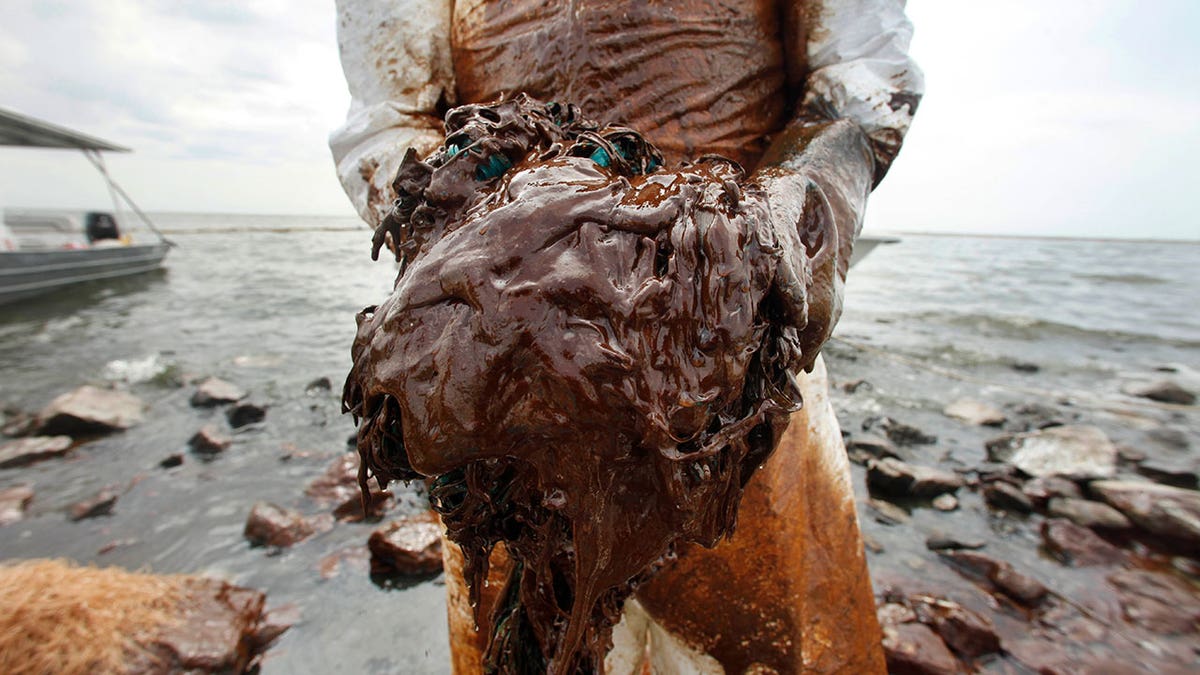- When a deadly explosion destroyed BP’s Deepwater Horizon drilling rig in the Gulf of Mexico, 134 million gallons of crude erupted into the sea.
- Workers involved in the cleanup were exposed to crude oil and chemicals, leading to health concerns.
- Despite billions spent on restitution, only a fraction was allocated to ill workers, with most receiving minimal compensation.
When a deadly explosion destroyed BP’s Deepwater Horizon drilling rig in the Gulf of Mexico, 134 million gallons of crude erupted into the sea over the next three months — and tens of thousands of ordinary people were hired to help clean up environmental devastation from the biggest offshore oil spill in U.S. history.
These workers were exposed to crude oil and the chemical dispersant Corexit while picking up tar balls along the shoreline, laying booms from fishing boats to soak up slicks and rescuing oil-covered birds.
Recognizing that some members of cleanup crews had likely become sick, BP agreed to a medical claims settlement two years after the 2010 disaster. Experts hailed it as “an extraordinary achievement” that would compensate workers fairly with little hassle.
OIL SPILL IN TRINIDAD PUSHES GOVERNMENT TO HIRE FOREIGN EXPERTS TO CONTAIN, REMOVE CAPSIZED BARGE
But it hasn’t turned out that way.

A cleanup worker picks up blobs of oil in absorbent snare on Queen Bess Island at the mouth of Barataria Bay near the Gulf of Mexico in Plaquemines Parish, Louisiana, on June 4, 2010. (AP Photo/Gerald Herbert, File)
The effort has fallen far short of expectations, leaving many workers who claimed lasting health effects stranded with little or no payment.
Through the settlement, BP has paid ill workers and coastal residents a tiny fraction — $67 million — of the billions the company has spent on restitution for economic and environmental damage. The vast majority — 79% — received no more than $1,300 each.
Many workers claiming illnesses from the spill were forced to sue — and they’ve fared worse. All but a handful of roughly 4,800 lawsuits seeking compensation for health problems have been dismissed.
TRINIDAD AND TOBAGO FACING ‘NATIONAL EMERGENCY’ AFTER MAJOR COASTAL OIL SPILL
Attorneys familiar with the cases say they are unaware of any that have gone to trial and know of only one that’s been settled. Former boat captain John Maas received $110,000 from BP for his lung ailments in 2022, according to a confidential copy of the settlement.
The repeated failures demonstrate how extremely difficult it is to prove to a court that a specific illness is caused by chemical exposure — even when those chemicals are recognized causes of illness more generally.
An Associated Press investigation that included dozens of interviews with cleanup workers, attorneys and experts, and a review of voluminous court filings revealed:
—A single switched word in the settlement prevented thousands of workers from receiving anything over the minimum of $1,300 each. To get more, they had to file individual lawsuits — an option that almost always led to defeat.
—Most federal judges hearing those cases required a level of proof connecting chemical exposure to worker illnesses that the lead government epidemiologist studying the spill says is likely impossible to meet.
—Big law firms representing dozens or even thousands of workers failed their clients in various ways. After BP accused one firm of manufacturing medical claims, its cases were dismissed in big batches.
Robin Greenwald, one of the plaintiffs’ attorneys who negotiated the settlement, said even her firm has not been able to win a single medical case against BP.
“I wanted people to get their day in court and they win or lose at trial,” said Greenwald, a former federal environmental prosecutor. “Let a jury decide. … But they weren’t even given the chance to do that.”
BP declined to comment for this story, citing ongoing litigation 14 years after the spill.
GETTING SICK
After the explosion on April 20, 2010, the spill was spectacular. A camera live-streamed the rupture on cable news, showing the world in real time gushing oil that wouldn’t stop. Oil floated on the Gulf and washed ashore, covering plants, birds and other animals.
To break up oil, roughly 1.8 million gallons of Corexit were dropped from planes and sprayed from boats — far more than previous U.S. oil spills. The manufacturer said it was safer than dish soap.
But lab research on human tissue and animals has revealed Corexit can damage cells that protect the airways and cause scarring that narrows breathing tubes, according to Dr. Veena Antony, a University of Alabama professor of pulmonary and critical care medicine who has studied Corexit’s effect on lung tissue. Over time, she said, the process can make it harder and harder to breathe.
“I genuinely believe that there was harm done and we didn’t realize the harm was being done — and now people are suffering,” said Antony, who testified as an expert witness in one suit against BP. “I would not, at the present time, put my hand even in Corexit without wearing double gloves.”
The current producer of Corexit, ChampionX, said the dispersant was pre-approved by the government for use on oil spills and the manufacturer had no role in deciding when or how to spray it.
Oil itself has long been known to cause illness. One of its toxic components is benzene, which can cause conditions ranging from skin irritation to cancer.
But now researchers, including Dale Sandler at the National Institutes of Health, are finding that spill workers exposed to amounts of oil assumed safe have suffered from dizziness, nausea, lung problems and heart attacks.
“The exposures on average were still pretty low,” said Sandler, an epidemiologist leading the GuLFSTUDY, a major effort to quantify workers’ exposure and track health woes over years. “What surprised us is that we did see a wide range of health effects that were associated with these exposures.”
Sandler said the study is the largest ever of an oil spill and is ongoing. “We’re looking at long-term risks like diabetes, cancer incidence,” she said.
What researchers have found so far is echoed by other studies, including one involving about 3,500 Coast Guard responders. The responders who reported breathing oil fumes were 40% to 50% more likely to have chronic obstructive pulmonary disease-like symptoms and sinus problems compared to those who said they didn’t breathe fumes. And responders who reported exposure to both oil and Corexit were more than twice as likely to suffer shortness of breath.
A PROMISING SETTLEMENT
Proving to a court that a specific person’s illness was likely caused by their exposure to oil or Corexit can be difficult.
Yet the settlement for medical claims was supposed to make it easier for workers: BP would agree exposure to the spill could cause a host of known health issues — and workers suffering from them could file claims for payment. Initially, attorneys advocating for the settlement said it could help as many as 200,000 possibly injured workers and residents.
The settlement also included $105 million from BP for regional health outreach and free health checkups for exposed workers every three years for 21 years.
But things quickly went awry.
The third-party administrator hired to handle claims, Garretson Resolution Group, initially rejected 78% of roughly 37,000 claims. After many were resubmitted, around 36% still were rejected and claimants received nothing.
Greenwald was especially frustrated her clients’ claims were repeatedly deemed deficient. “We had many a meeting with Garretson’s team to try to shake them loose of some of their narrow reading and obsession with deficiencies,” she said. “We clearly knew the claim form. We negotiated it.”
Matthew Garretson, founder of Garretson Resolution Group, defended his claims handling in an email, saying, “it was the process the parties agreed upon and we had to administer the settlement exactly in the way the parties’ Settlement Agreement mandated.” The company was paid roughly $115 million to $120 million for administering claims and for the outreach program and medical checkup effort as of 2018, he said.
There was a bigger problem.
At the most basic level, workers could submit affidavits attesting to their medical problems and collect $1,300 — and residents could collect $900. About 18,000 received that much.
Those with longer-term illnesses who had proof from medical tests could collect up to $60,700, or more if they had been hospitalized.
But few people had that proof. Forty of about 23,000 with approved claims collected the maximum award — less than 0.2%.
Many people lacked health insurance or easy access to a doctor and the required medical tests — a problem U.S. District Court Judge Carl Barbier, who approved the settlement, acknowledged in a hearing.
“Speaking for south Louisiana, I know — you’re dealing with people who are probably at the lower end of the socioeconomic scale. Most of these people, I feel sure, likely have no health insurance,” he said.
Even when people did seek medical attention, doctors untrained in treating chemical exposures often did not link illnesses to a patient’s cleanup work in medical records, according to Greenwald.
THE NATIONS CLIENTS
The Nations Law Firm, based in Houston, represented thousands of workers like Paul Loup IV, who helped clean an oil-contaminated beach in Pascagoula, Mississippi for several months.
Loup, 68, says he now has chronic respiratory issues, making it hard to stand or speak at length. He quit his job as a procurement manager because it involved too much travel.
The firm had wanted to help clients collect more than the settlement’s $1,300 minimum, so it developed a plan to obtain needed medical proof.
ENVIRONMENTAL CONCERNS MOUNT AS TRINIDAD OIL SPILL REPORTEDLY REACHES BEACHES HUNDREDS OF MILES AWAY
It was an assembly line. Out-of-state nurse practitioners who were paid $20 per plaintiff entered medical histories based on information the law firm — not a doctor — provided. Firm-designed forms listed illnesses that paid more under the settlement — and doctors could simply circle them. The forms included a statement linking a patient’s illness to oil spill work — with a line for the doctor to sign. Doctors didn’t keep their own patient records.
While such a process might seem suspect, firm founder Howard Nations said in an interview that he met with the claims administrator Garretson to try to develop an acceptable one.
Garretson rejected the claims — not based on the process, but on a deadline.
THE DEADLINE AND A SWITCHED WORD
The settlement was designed to make it easy to collect money for illnesses that surfaced quickly after crude oil exposure. People with diseases that can show up years later — such as cancer — would be forced to file individual federal lawsuits.
Early settlement drafts defined this second group as people with a disease that “manifests” after April 16, 2012. However, a later draft changed the word “manifests” to “diagnosed.”
In 2014, BP seized on that change to argue no one diagnosed after the deadline could receive an award for a long-term illness through the settlement, regardless of when they first got sick. Instead, they would need to sue individually to get compensated.
Judge Barbier said that’s not how he was led to believe the settlement he okayed would work.
“It is rather strange … that the court would approve a settlement, a class settlement that really doesn’t settle thousands of claims and requires them to file another lawsuit,” Barbier said at a 2014 hearing. “I mean, it doesn’t sound like much of a settlement.”
BP attorneys said any other interpretation would invite fraud, allowing opportunistic law firms to pay for a medical diagnosis after the deadline to get a settlement claims payout. They also said the word change was requested by the workers’ own attorneys, and Stephen Herman, co-lead counsel for plaintiffs’ attorneys, testified they didn’t recall how it happened.
Despite his doubts, Barbier said he had to follow the settlement language.
His ruling forced thousands of workers out of the relatively easy administrative claims process into federal courts throughout the South.
THE FEDERAL LAWSUITS
The ruling was devastating for Nations clients whose only option was to file federal lawsuits.
After BP attorneys alleged in Mississippi federal court that the firm manufactured medical diagnoses, Nations agreed to dismiss its cases by the dozens. In an interview, Nations did not deny BP’s allegations but said the cases were unwinnable without an adequate expert witness.
Loup, the former beach cleanup worker, said he didn’t know until informed by a reporter last year that his case had been dismissed years earlier. “I call (Nations) every six months or so … and they’ve just said it’s going to take some time,” he said.
Another Nations client was Jeff Herring, the deckhand of Maas, the boat captain believed to be the only person whose case reached a settlement.
When their boat was sprayed with Corexit, Herring started throwing up so badly an ambulance was called to pick him up. Although released from the hospital after a few days, he developed chronic sinus and respiratory problems, according to his lawsuit.
Months later, a doctor at an oil spill medical station referred him to a specialist, and he was hospitalized again, said Herring, now 39. An X-ray found spots on his lungs, and he was supposed to go to New Orleans for further testing but never did.
“That would have took another two weeks being in a hospital over there,” he said. “I couldn’t because I had to get back to work.”
Noting he had no insurance, Herring said he received about $8,000 through the claims process — not enough to even pay hospital bills.
Herring’s suit was thrown out in 2020 along with 235 other Nations cases, but he said he wasn’t told.
Howard Nations said the firm communicated with clients about the status of their cases and although the individual suits were dismissed, he intends to go back to Judge Barbier with new arguments.
EXPERT WITNESSES
Other law firms met a different obstacle:
Workers filing individual lawsuits have to prove they were exposed to enough oil or dispersant to — more likely than not — cause their illness.
The workers’ experts relied on studies, such as those from the National Institutes of Health and the Coast Guard, that found people exposed to oil and Corexit were more likely to develop certain illnesses.
But BP’s experts maintained workers needed to show exactly how much oil and dispersant they had inhaled or ingested and that it was sufficient to cause their sickness.
Greenwald, the attorney who helped craft the settlement, said meeting such a standard is almost impossible: “I mean, ‘How deep did you breathe? Right at the moment you were standing there, was the wind blowing?'” she said. “What mortal human would be able to testify about that?”
Most judges have sided with BP, rejecting workers’ experts as unreliable and effectively ending the cases.
Sandler, the NIH epidemiologist, said its researchers went to great lengths to develop data on exposure like nothing ever been done before. “I’m not sure that they’ll ever meet the standards that the court is imposing on what constitutes evidence,” she said.
It also can be difficult to find an expert witness who knows the science but doesn’t have a conflict of interest through work with the oil industry.
The Falcon Law Firm brought on Jerald Cook, a retired Navy physician trained in occupational and environmental medicine, as an expert on numerous cases. He was rejected again and again by judges as BP poked holes in his professional history and work.
“Your report really doesn’t balance the evidence favoring your conclusions with the evidence that disfavors your conclusions; isn’t that fair?” a BP attorney asked Cook in a deposition.
“Yeah. I think that’s — that’s fair,” Cook replied.
He declined comment, and Falcon did not reply to requests for comment.
Some law firms that took on hundreds of cases have simply buckled under the strain, begging judges for more time so their overloaded experts could produce reports.
LOOKING FORWARD
It’s not completely over.
The Downs Law Group, which has lost hundreds of cases against BP, is appealing in the 5th and the 11th U.S. Circuit Courts of Appeals, hoping they’ll rule federal district judges have misconstrued the level of proof needed for toxic exposure cases. One of those judges said the issue is “very ripe for the Supreme Court to resolve.”
“It has a broader reach than the BP oil spill,” said Jason Clark, a Downs attorney. “If the burden is one that’s too high for any plaintiff to meet, then a lot of people who are exposed … are never going to see justice.”
CLICK HERE TO GET THE FOX NEWS APP
Meanwhile, Downs is talking to thousands of people interested in suing over illnesses such as cancer that emerged years after the spill, Clark said.
Sandler, the NIH epidemiologist, said the high burden of proof demanded by most judges means “people can’t win.”
“I think at the end of the day, did the oil from the oil spill make people sick? Yes,” Sandler said. “Now, courts may view this from a very different lens, but from a public health standpoint — yes, the oil spill made people sick.”









